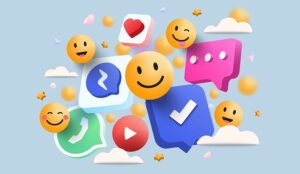If omnichannel communications is the goal, the glue that holds all of this together, then Application-to-Person (A2P) Messaging APIs are the foundation.
When developers start talking about APIs a lot of marketers start getting a little shaky. And it’s easy to get confused about what any API does – much less what an A2P messaging API does.
The good news is that it’s not complicated. We’re here to help guide you and make sense of messaging APIs for omnichannel marketing.
What is an A2P API and What do I do With it?
Let’s start with APIs first. API stands for Application Programming Interface. They are a simple set of instructions that developers use to get one program to “talk” to another. For example, when a website lets you log in with your LinkedIn, Twitter, or Facebook account. You can do this thanks to login APIs.
The website you’re visiting is using the social networks’ login APIs to help you access the site without having to register. Developers use all kinds of APIs to connect different apps together to create all the amazing apps we use today.
APIs generally support a few of the main programming languages, but that isn’t (usually) something marketers need to worry about it. APIs are instructions to connect applications to do stuff and work together. Cool.
The Application-to-Person (A2P) part is an API that lets an application (let’s say the computers at your bank or an airline booking system) send messages to a person (like you) over chat apps, email, SMS, phone call, or even to an app as a push notification.
If your bank wants to let you know you’ve received a deposit, they would use an A2P API to create the email and send it to you. If there is a gate change for your flight, an A2P API would be used to create the SMS to be sent to you.
Businesses use A2P APIs in many of different ways. What separates the messaging APIs is how many different kinds of messages you can send with them. Some might only do email.
Some might only be used for calling and voice commands (the well-known “press 1 for accounts, press 2 for billing, press 3 and listen to our hold music forever…”).
Others connect a host of different communications tools together so one internal system (say the shipping part of an eCommerce system) can send out emails, SMS, voice, or whatever else a customer might want.
For example, you bought something online. You get the receipt for your purchase via email, the store’s mobile app pops up a notification when your item ships, and you get an SMS with the tracking number for your package. Three different messages sent from the same system through one A2P API.
For a marketer, if your internal systems are connected to a good A2P API, then you have a lot of options for sending your customers more information, in more different ways, and you can leave which medium they want to use (mostly) up to them.
Newsletters don’t make sense over SMS, but shipping and billing notifications could be email or SMS. Customer support can start (or finish) with an email, a phone call, or a request through your app.
When you have something more powerful than just a single channel API, the question changes from “What can I do?” to “Wow, what am I going to do first?”
What Makes a Good A2P Messaging API?
Plain and simple, a good API is flexible, well documented, can be used with a range of programming languages, and can scale from 100 to 1,000,000,000 messages without recoding your app. But what does that “really” mean? Why should I as a marketer care whether an API is good or not? Three words.
Shorter. Development. Time.
Good APIs tend to be easier to implement and integrate into your systems. Easier is good.
Good APIs connect with developer sites like Github and services like IFTTT and Zapier so it’s easier for developers to develop applications and see examples how the API works with other apps.
Since APIs are the foundation for apps, the glue that sticks them together, and the bridges between apps, the better APIs are, the better they are to build with. If you think of APIs in terms of building blocks, glue, and bridges, it’s easier to see how APIs fit in with your marketing tools.
How Does This Fit Within Omnichannel Communications?
When you take an A2P API and connect it with your CRM, support ticket systems, marketing automation system, newsletters, mobile app, and website you have an omnichannel marketing engine.
It’s the power and flexibility of the API that allows your customers to send an SMS to get support or let you run a coupon promotion from your app and website or offer updates over email or PIN for 2FA via SMS or Voice, all of that is powered by the messaging API.
Without A2P APIs we couldn’t build most of today’s apps. APIs allow developers to write one (very complex) thing, like how to connect to an SMS gateway using the API, and reuse it over and over again. Without APIs developers would have to write these connections themselves each and every time.
How do I Get Started?
Integrating an A2P API into your app or infrastructure might be a developer’s job, but before the project reaches your developers, you have to decide what you want to do.
A2P is about engaging your customers in new and dynamic ways. Consumers want a say in how they are contacted. Messaging APIs are the way to get there.
But there’s a catch. To be effective you not only need a solid API that connects to email, SMS, voice, and push, you need global scale and coverage to offer all messaging options around the world.
Without global scale and coverage, you aren’t truly offering a new customer engagement solution. You’re, in effect, saying some customers in some parts of the world are more important than others.
No customer wants to feel unimportant when they can’t send an SMS to you from their country. Make sure all of your customers feel connected and important.
When connecting with your customers is critical to your business, only the best, most reliable, and far-reaching API will do the job.
Author: Guest Author
Published On: 19th Jul 2021
Read more about - Guest Blogs, Infobip



































